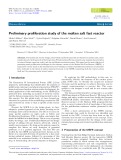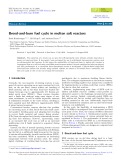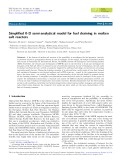
EPJ Nuclear Sci. Technol. 5, 14 (2019)
c
F. Di Lecce et al. published by EDP Sciences, 2019
https://doi.org/10.1051/epjn/2019028
Nuclear
Sciences
& Technologies
Available online at:
https://www.epj-n.org
REGULAR ARTICLE
Simplified 0-D semi-analytical model for fuel draining in molten
salt reactors
Francesco Di Lecce1, Antonio Cammi2,*,Sandra Dulla1, Stefano Lorenzi2, and Piero Ravetto1
1Politecnico di Torino, Dipartimento Energia, NEMO group, Torino, Italy
2Politecnico di Milano, Department of Energy, Nuclear Engineering Division, Milano, Italy
Received: 23 April 2019 / Received in final form: 15 July 2019 / Accepted: 26 August 2019
Abstract. A key feature of molten salt reactors is the possibility to reconfigure the fuel geometry (actively
or passively driven by gravitational forces) in case of accidents. In this regard, the design of reference molten
salt reactor of Generation IV International Forum, the MSFR, foresees the Emergency core Draining System
(EDS). Therefore, the research and development of MSFRs move in the direction to study and investigate the
dynamics of the fuel salt when it is drained in case of accidental situations. In case of emergency, the salt could
be drained out from the core, actively or passively triggered by melting of salt plugs, and stored into a draining
tank underneath the core. During the draining transient, it is relevant from a safety point of view that thermal
and mechanical damages to core internal surfaces and to EDS structure – caused by the temperature increase
due to the decay heat – are avoided. In addition, the subcriticality of the fuel salt should be granted during
all the draining transients. A simplified zero-dimensional semi-analytical model is developed in this paper to
capture the multiphysics interactions, to separate and analyse the different physical phenomena involved and
to focus on time evolutions of temperature and system reactivity. Results demonstrate that the fuel draining
occurs in safe conditions, both from the thermal (temperature-related internal surface damages) and neutronic
(sub-critical states dominate the transient) view points and show which are the main characteristics of the
fuel salt draining transient.
1 Introduction
Molten Salt Fast Reactor (MSFR) is the reference liquid-
fuelled reactor concept in the frame of the Generation IV
International Forum (GIV) [1]. Main fast spectrum liquid-
fuelled reactor concepts are under investigation nowadays:
the European Molten Salt Fast Reactor, the Russian
MOlten Salt Actinide Recycler and Trasmuter (MOSART
[2]) and other concepts worldwide (Terrapower MCFR,
Elysium MCSFR, Indian Molten Salt Breeder Reactor,
Moltex Energy Stable Salt Reactor). In this paper, the
first one is considered as reference, which was studied in
the frame of the EVOL (Evaluation and Viability of Liq-
uid fuel) Euratom project and is currently being analyised
within the SAMOFAR (Safety Assessment of the Molten
Salt Fast Reactor) European H2020 project [3].1
The main innovative feature of molten salt reactors con-
sists in the liquid state of the nuclear fuel. The immediate
benefits that liquid fuels entail are the strong negative
*e-mail: antonio.cammi@polimi.it
1A Paradigm Shift in Nuclear Reactor Safety with the Molten Salt
Fast Reactor, Grant Agreement number: 661891 | SAMOFAR, Euratom
research and training programme (2014–2018).
reactivity temperature feedback [4], the versatility in
terms of composition and the possibility of reconfigura-
tion of the fuel geometry. Specifically, the latter feature
implies the opportunity of a new fully passive safety sys-
tems driven by the gravitational force, called Emergency
Draining System (EDS) in the frame of SAMOFAR. The
EDS could be triggered actively by operator or passively
by salt plugs that melt when the temperature reaches a
critical value (1755 ◦C) [5].
The safety assessments of the MSFR requires the anal-
ysis of accidental conditions that may occur during the
reactor operation. A possible initiating event for the drain-
ing of the salt is the unintentional injection of fissile
material that may bring the reactor in supercriticality
conditions. In this situation, the plugs may be opened,
to let the salt leaving the core and to reconfigure the sys-
tem into a subcritical conditions. After the draining of the
salt, a proper cooling of the fuel has to be envisaged and
maintained to avoid an undesired increase in the fuel tem-
perature inside the EDS that could damage the structure
of the system.
Therefore, the accidental scenario of interest for the
present analysis considers the possibility to drain the fuel
out of the core cavity into a tank placed underneath it,
This is an Open Access article distributed under the terms of the Creative Commons Attribution License (http://creativecommons.org/licenses/by/4.0),
which permits unrestricted use, distribution, and reproduction in any medium, provided the original work is properly cited.























